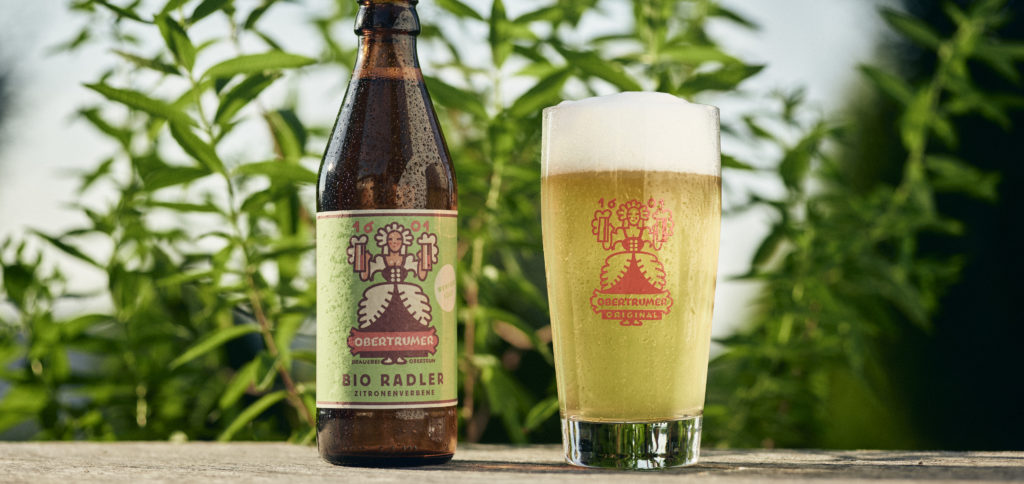Mixed beer drinks really in the fast lane

Mint Radler, cola beer and lime-flavored wheat beer: Breweries are reaching new target groups with low-alcohol mixed beer drinks. Mixtures with daring fruit combinations promise a hefty surge in revenue among younger target groups.
Beer consumption in Germany may have been stagnating for years – with slight, seasonal fluctuations – but mixed beverages that incorporate beer are experiencing a steady upswing. The concept of combining beer with lemonade or soda to create a Radler, Russ’n-Maß, Alsterwasser or Diesel beverage is nothing new, though. And the Berliner Weisse, with a shot of raspberry or woodruff syrup, has also been a staple at Berlin pubs for dozens of years.
Refreshing mixed beer beverages sitting pretty in the beer market
The new generation of mixed beer drinks is giving rise to trends that are particularly popular among young consumers. Whether the combinations include lime, orange, mint, guarana, curuba or dragonfruit: For the most part, growth in recent years has been in the double-digits. According to current figures from the German Statistical Office, sales have risen by more than 10 percent: from 3,963,724 in 2017 to 4,377,157 hectoliters in 2018. That is the highest figure ever – even considering these figures don’t include sales of nonalcoholic mixed beer beverages that aren’t included in beer tax statistics. The German Brauerbund brewers’ association can also confirm that mixed beer beverages – with and without alcohol – are now firmly established in the beer market. According to numbers from the association, the market share in this segment is already more than 20 percent.
Large and small breweries get into the mix
Numerous large and small breweries have already responded to the trend. Warsteiner, for instance, introduced two new mixed beer drinks in March: the minty lime-flavored Summer Breeze and Sunrise, a burst of orange-pomegranate flavor. Warsteiner hopes its exotic flavors and hip names will appeal to both beer and cocktail enthusiasts. “With the two summer blends, we are continuing down the innovative path we started last year with our limited edition Moscow Mule,” says Marcus Wendel, marketing director at the Warsteiner Group.
The Köstritzer brewery, maker of Schwarzbier (a dark, heavy brew that translates as “black beer”), also wants to throw its hat in the ring. It’s going after new target groups with two new mixed beer beverages in an attempt to expand its range of specialty drinks. The Radler Limette with 3 percent alcohol is a blend of Kellerbier and fruity, crisp lime juice, while Köstritzer Kirsche is made up of 60 percent Schwarzbier and 40 percent sweet cherry soda. “Both of these new products are true innovations in the spirit of light beer enjoyment,” says Stefan Didt, CEO of Köstritzer. And so once more, his company is opening up entirely new taste sensations for consumers.
Mixed beer drinks on the upswing worldwide
German breweries aren’t the only ones making inroads with mixed beer beverages. In the U.S., the Netherlands and especially in Austria, more and more breweries are turning to mixed beer beverages with uncommon ingredients. Several U.S. breweries such as Boulevard Brewing Company, Great Divide Brewing and Victory Brewing often feature multiple varieties. Brewing giant Amstel from the Netherlands now offers a refreshing Radler as part of its standard selection.
Organic and natural Radlers are increasingly popular
New creations of organic and natural Radler beverages are especially popular, particularly among regional and smaller breweries. According to their own statements, the Welde Brewery in the German town of Plankstadt as well as the two Austrian producers Gösser and Stiegl are enjoying significant success with new varieties. Just a few months ago, Trumer, a private brewery based in the Austrian town of Obertrum, launched Bio Radler, an elaborately produced, Märzen-style sour beer. The beer gets its tart crispness from a natural lactic acid fermentation process at the brewery. A cold extraction of organic lemon verbena is paired with regional beet sugar to create a homemade lemonade, which is then added to the 2.6 percent alcohol beer.
Amid heightened consumer awareness, industry experts forecast that mixed beer drinks will continue their victory march in the coming years. Many brewers are thus turning to fresh product ideas and new marketing concepts to bring new energy to their product ranges and, in doing so, are responding to young consumers’ demand for new taste sensations.
